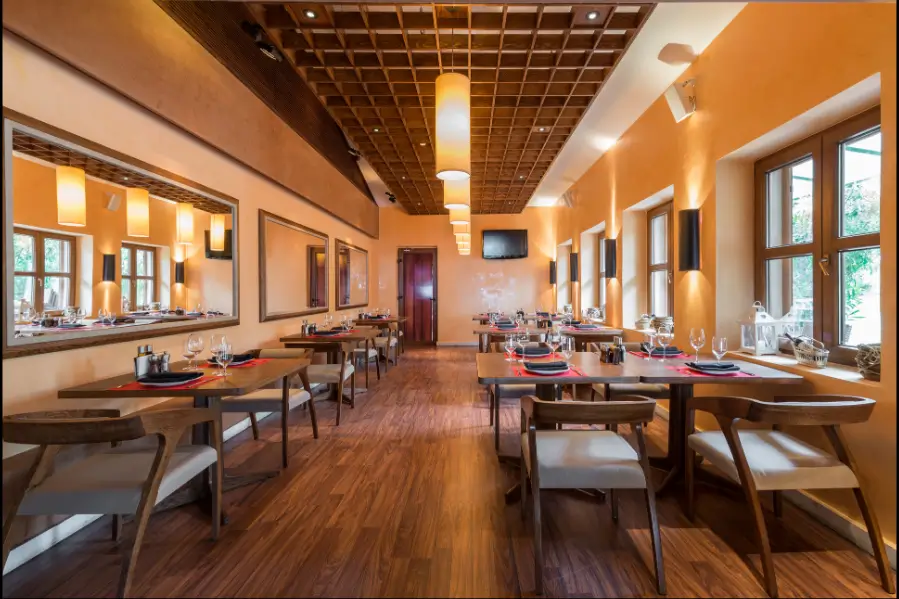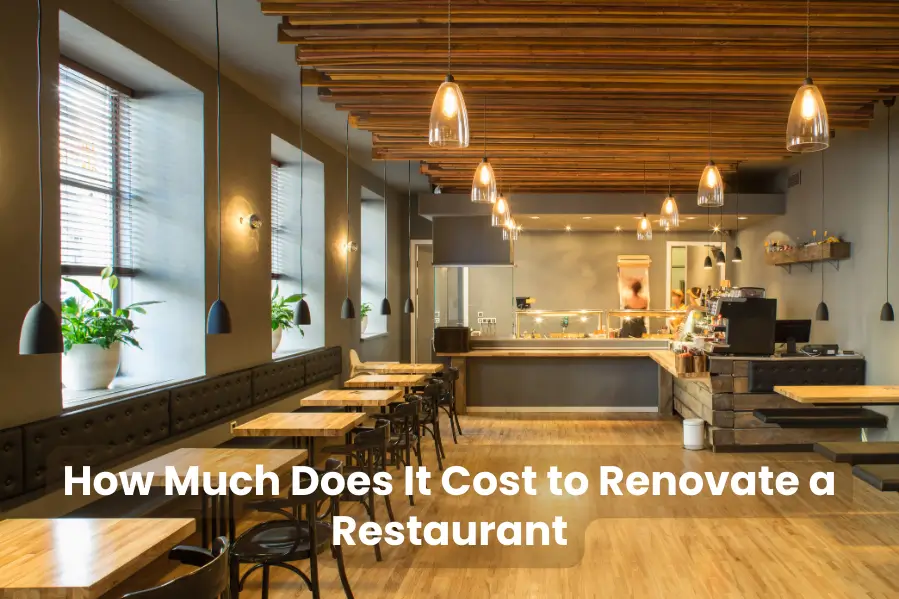Customers are often attracted to restaurants that stay up-to-date with the latest interior and architectural design trends. Renovating the restaurant is a substantial investment that holds the potential to rejuvenate your business, draw in fresh clients, and boost profits.
So, if you want to maintain the appeal of your restaurant and continue attracting patrons, it’s essential to plan for periodic renovations.
In this article, we’ll thoroughly explore the diverse expenses required for restaurant renovation and offer guidance on how to handle your budget wisely. So, let’s get started!
What is the Average Cost to Renovate a Restaurant?
According to a recent report from Building Journal, renovating a 5,000-square-foot restaurant with average finishes costs about $160 per square foot nationally, totaling $480,000. However, prices can change depending on where you are.
For instance, it could be higher in expensive cities like New York and Philadelphia, around $216 and $180 per square foot, respectively. Jonathan Garnett, who is a creative director at MNDPC, added that in NYC, costs for the front part of the restaurant could be $300-350 per square foot, while for the back, it could be about $200 per square foot.
| Location | Average Cost per Square Foot |
|---|---|
| National Average | $160 |
| New York City | Front: $300-350 Back: $200 |
| Philadelphia | $180 |
These details show how important it is to plan your budget carefully and understand how costs can differ depending on location.
Breakdown of Renovation Costs of Restaurants in 2024

In 2024, renovating a restaurant involves a thorough breakdown of costs to ensure a successful project.
1. Restaurant Design & Building Materials
The materials used in a restaurant’s design and construction greatly influence its ambiance and style. Everything from flooring to countertops contributes to the overall look and feel of the space.
- Materials like hardwood flooring, granite countertops, and high-quality doors and windows can elevate the restaurant’s aesthetic appeal, but they come with a higher price tag.
- On the other hand, options like epoxy or laminate flooring provide a more budget-friendly alternative.
The size of the restaurant also significantly influences material costs. Larger establishments require more materials to cover the space, which can further impact the overall expense of the renovation. Ultimately, selecting the right materials involves finding a balance between style, cost, and durability.
2. Equipment Cost
Renovating a restaurant involves various costs, especially for equipment. The average expense for outfitting a 1,000-square-foot restaurant, including a bar and kitchen gear, is around $75,000. However, this cost can change based on the type of equipment chosen.
If you want to save money, opt for used equipment from other businesses. However, it’s crucial to have a technician inspect it first to ensure its functionality. This inspection typically costs a few hundred dollars but helps avoid future problems.
Alternatively, leasing equipment is an option. It requires less upfront payment. However, this might result in higher costs over time. Yet, leasing companies often cover repairs and may even provide additional items like dishwasher detergent.
3. Restaurant Furnishings
Furnishings play a pivotal role in creating a restaurant’s interior ambiance. Chairs, Tables, decorative accents, and lighting fixtures collectively define the ambiance of the establishment.
The materials you will choose for furnishings impact not only the visual appeal but also the financial aspect of the project.
- Opt for metal or plastic chairs and tables.
- They are more cost-effective compared to their wooden counterparts.
Additionally, a restaurant’s size has a significant impact on furnishing costs. Bigger spaces require additional furniture and seating to fit more people, which raises expenses.
4. Utility Work Cost
Utility work includes installing and modifying essential systems like gas lines, electrical wiring, HVAC (heating, ventilation, and air conditioning), and plumbing. However, it is not necessary; it is crucial for safety and functionality.
Planning for utility work is essential, especially if adding new sections, as it significantly impacts functionality and customer experience. Going green with energy-efficient fixtures can save money in the long run.
5. Exhaust System
An exhaust system is a crucial investment for any food service. It’s not just about removing smoke, steam, grease, and gas but also about creating a safe environment for workers and customers.
Smart Remodeling LLC prioritizes using cutting-edge technology to design and place these systems effectively. The cost of an exhaust system is significant but worth it. It’s about more than just its power, noise level, and overall effectiveness.
When working with commercial kitchen renovation specialists like Smart Remodeling LLC, you can expect a recommendation tailored to your needs—powerful enough to keep your kitchen safe and efficient while effectively managing costs.
6. Permits Cost
Permits involve approvals from various government departments, like the fire and buildings departments, which can add to the overall renovation cost. Building permits, for instance, typically range from $50 to $1,000 depending on factors like the age of the building and location.
Although permits don’t cost much, they can affect the renovation budget by around $5,000 on average. This cost can fluctuate, so make sure you discuss it with your contractor early on.
7. Opportunity cost of being closed
Major structural changes or even smaller renovations can make the restaurant unusable for a period. This downtime results in missed sales and reservations. It’s crucial to estimate the potential loss of revenue during this period and plan for it accordingly.
However, there’s a silver lining, as restaurant sales typically increase by 10 to 20% after renovations. While the closure may disrupt normal operations, you can try alternative revenue streams like online orders, delivery, or outdoor seating, which can help mitigate some losses.
8. Contractors & Labor Cost
Contractors and labor are the ones that can make and break your project. Invest in reputable contractors and skilled labor. Their expertise ensures quality work and compliance with regulations. It will also ensure the renovation is done right the first time and minimize the risk of costly rework or regulatory issues.
On average, restaurant remodeling costs range from $200 to $250 per square foot. However, this can fluctuate based on various things, especially geographical location. Urban areas like Los Angeles or Washington, DC, typically have higher labor and material costs than rural areas.
How Can You Get Funding for Your Restaurant Renovations?

Funding and budget management are crucial components of any restaurant renovation project. Here are some options for financing your restaurant renovations.
1. Small Business Loans
Small business loans are a common and accessible option for financing restaurant renovations. These loans typically come with reasonable interest rates and flexible repayment terms. So, it’s an attractive choice for funding renovations. Additionally, small business loans often require minimal collateral, which can benefit restaurant owners.
2. Investors and Partnerships
Getting investors or partners on board can help you raise the necessary capital for renovations. Investors may be individuals or companies willing to invest in the restaurant in exchange for a stake in the business.
While this option can offer great financial support, it’s essential to consider that investors may want a say in your business operations or expect a share of profits. So, restaurant owners should carefully evaluate potential investors and partnerships to ensure they align with their future plans.
3. Crowdfunding and Community Support
Crowdfunding platforms and community support can be a good option for restaurants with a strong local following or unique concept.
Crowdfunding allows restaurant owners to raise funds by appealing to a broad audience of supporters who contribute small amounts of money. This approach provides financial support and encourages a sense of community engagement and loyalty.
In return, restaurants can offer incentives such as exclusive perks or discounts to motivate backers to contribute.
Restaurant Remodeling Experts in Houston, Texas
In Houston, Texas, Smart Remodeling LLC stands out as the go-to choice for restaurant renovations. With a focus on commercial projects, we specialize in modernizing spaces and boosting business appeal.
Our services include free estimates for accurate budget planning, ensuring transparency from the start. With over 13 years of experience, we guarantee reliable, on-time project completion backed by a stellar track record of successful renovations.
We are happy to announce that Smart Remodeling LLC was Recognized with the Best of Houzz Award for 2024 and boasts zero BBB complaints. We have also completed over 1,000 projects to date. Take the first step towards your dream renovation by scheduling a free consultation with us today.
Conclusion
A restaurant renovation involves a wide range of costs and options. However, with careful planning, budgeting, and the right advice, it can lead to a revitalized business and increased customer satisfaction. Always prepare for the unexpected and seek professional guidance to ensure your renovation goes smoothly.






